|
|
|
Sort Order |
|
|
|
Items / Page
|
|
|
|
|
|
|
| Srl | Item |
| 1 |
ID:
137235
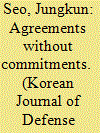

|
|
|
|
|
| Summary/Abstract |
Twenty years after the deal struck between the United States and North Korea over the nuclear crisis, the security environment on the Korean Peninsula remains unstable. When it comes to the U.S.-North Korea Agreed Framework from 1994 through 2002, previous research has paid scant attention to how the U.S. Congress responded to President Clinton’s accord with the Pyongyang regime. This article
provides a rare empirical assessment of what led America’s lawmakers to uphold or overturn the executive agreements with North Korea. The bottom-line finding is that politics hardly stops at the water’s edge, with “politics-as-usual” forces such as partisan conflicts ultimately having derailed Congressional commitments to the U.S.-DPRK accords. The results shed light on how and why domestic politics often redirects the course of international agreements, particularly in the era of
polarized politics.
|
|
|
|
|
|
|
|
|
|
|
|
|
|
|
|
| 2 |
ID:
137226
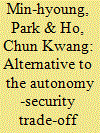

|
|
|
|
|
| Summary/Abstract |
Most of the alliances that were formed during the Cold War period were known as a so-called “asymmetric alliance,” which means strong states provide one-sided support for the partner in a relationship at the expense of the weaker power’s autonomy. In an asymmetric alliance, a weak state gets full security support from the superpower, but in return, the weak state loses its autonomy. In this case, there is a trade-off between security and autonomy of the weaker state. This is what the Autonomy-Security Trade-off Model suggests. However, after the end of the Cold War, the weak powers, especially the developing country, have tried to increase its autonomy without any loss of its security—unlike what the Autonomy-Security Trade-Off Model argues. In this case, there may not be necessarily a trade-off between autonomy and security if a weak state decides to increase both autonomy and security simultaneously. The weak state does not usually want to lose its security, therefore it tries to find a strategy that can increase its autonomy without decreasing its security. In this sense, this paper argues that the Autonomy-Security Trade-off model has limitations to explain the above kind of national action after the Cold War. In line with this, the goal of this paper is to offer an alternative model to explain an asymmetric alliance relationship by looking at the case of the
ROK-U.S. alliance at the turn of the twenty-first century.
|
|
|
|
|
|
|
|
|
|
|
|
|
|
|
|
| 3 |
ID:
137223


|
|
|
|
|
| Summary/Abstract |
South Korea and Japan have experienced their worst deterioration of bilateral relations since 2012. What are the long-term prospects for this relationship? Will it continue on this negative trajectory or recover positively in the long term? Challenging the conventional view that supports the former conclusion, this paper argues for a positive outlook for the relationship in the long term. This is defended from a structural perspective relying on two long-term strategic trends for Northeast/ East Asia—the elevated uncertainty in the regional environment (due to North Korea and China’s strategic rise); and the rising strain on the U.S. military presence in both countries. In response to these structural pressures, South Korea and Japan will adapt and adopt strategies to defend their national security within a reformed U.S. alliance structure and strengthen strategic cooperation through bilateral and trilateral (with the United States) means.
|
|
|
|
|
|
|
|
|
|
|
|
|
|
|
|
| 4 |
ID:
137234
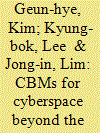

|
|
|
|
|
| Summary/Abstract |
This paper aims to analyze confidence-building measures (CBMs) for cyberspace taking place in Northeast Asia. Accordingly, it explores features of cyber security in the Northeast Asian region and concepts of CBMs for cyberspace. Then, it studies networks of CBMs for cyberspace that took place on the government level in the region from 2009 through the first half of 2014 by using the network analysis method, which is useful for studying current social relations. This study analyzes the structure of CBMs networks used in the region for the past six years and the actors. Conclusions of this study are as follows: First, CBMs for cyberspace in Northeast Asia are focused on the United States. Second, the CBMs in the region have similar features to those of traditional security cooperation. Thirdly, they are strongly based on realism. From the perspective of networks, this study is meaningful in that it used a macro approach to analyze CBMs, which was difficult to perform by using conventional methods.
|
|
|
|
|
|
|
|
|
|
|
|
|
|
|
|
| 5 |
ID:
137239
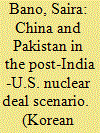

|
|
|
|
|
| Summary/Abstract |
Nuclear relations in South Asia cannot be fully analyzed without taking into account the China factor. After the May 1998 nuclear tests, a substantive amount of strategic literature has been focused on Indian and Pakistani nuclear postures and policies, respectively. However, their integral links with China in transforming South Asia’s nuclear environment remains one critical component that has not
been adequately examined. Multifaceted cooperation, competition and conflict have engulfed this triangle since the India-U.S. nuclear deal. This deal has significantly increased India’s nuclear weapons capability, and hence exacerbated the security dilemma of Pakistan and China, which has important implications for the strategic stability in the region. This paper analyses the strategic implications of this deal for the nuclear triangle and argues that the nuclear triangle will remain complex with inherent risks as well as pose challenges to the region’s strategic stability. China-India-Pakistan nuclear strategies will be determined by the larger triangle of U.S.-China-India relations, which will define the politics of South Asia as well as the larger Asian landscape.
|
|
|
|
|
|
|
|
|
|
|
|
|
|
|
|
| 6 |
ID:
137231


|
|
|
|
|
| Summary/Abstract |
This paper intends to propose countermeasures against increasingly sophisticated North Korean cyberterrorism through analysis of the cyber attack carried out by North Korea on March 20, 2013, which targeted South Korea’s major television stations and financial institutions, and also the attack of June 25, 2013, which was directed at South Korea’s government. These cyber attacks not only caused South Korea’s major television stations and banks to suffer from frozen computer terminals,
but also paralyzed websites including those belonging to the Presidential Office, the Prime Minister’s Office, government institutions and local media companies. This article addresses, firstly, the reasons why cyber attacks are now targeting the websites of media companies and financial institutions, whereas in the past they were intended to paralyze the national government by means of DDoS attacks. Secondly, the article attempts to predict the kinds of attack that can be expected in the future. Thirdly, in order to ensure that there are sound defenses against the continually growing threat of cyber terrorism, the article proposes an optimal system of countermeasures, describing related regulations, response strategies, and security personnel.
|
|
|
|
|
|
|
|
|
|
|
|
|
|
|
|
| 7 |
ID:
137228
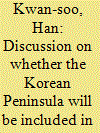

|
|
|
|
|
| Summary/Abstract |
This study aims to discuss whether the Korean Peninsula is included among the core interests claimed by China. The core interests of China are those interests that it is unwilling to negotiate over, and interests that they will even use military power to protect. China’s official core interests have so far been limited to Taiwan, Tibet and Xinjiang, but their list of core interests has been expanding in scope
since the Diaoyu/Senkaku Islands dispute. Furthermore, including the Korean Peninsula among China’s core interests leads to an immense ripple-effect on not only South Korea but also the security of Northeast Asia and U.S.-China relations. This study analyzes the following research questions: What are the core interests of China? Is the Korean Peninsula included in China’s core interests? Will the Korean Peninsula only be included in China’s core interests in the event of an emergency? If it is included, what is the specific object or likely scenario? This study conducts an in-depth analysis of the questions above and provides policy implications for the South Korean government.
|
|
|
|
|
|
|
|
|
|
|
|
|
|
|
|
| 8 |
ID:
137220


|
|
|
|
|
| Summary/Abstract |
The shale oil and gas production boom has played a significant role in bringing about the recent precipitous fall in oil and gas prices, and in catapulting the United States into first place for oil production last year, ahead of Saudi Arabia. A number of factors at the core of the boom in the United States have contributed to its success: the combination of technological breakthroughs (e.g., horizontal drilling and hydraulic fracturing); talented entrepreneurship; a business-friendly financial
market; technological R/D initiatives supported by the government; favorable geological conditions; and the property-rights regime. The EU and Asia also stand to gain from the shale windfall; Russia, Saudi Arabia, Iran, and other OPEC members, on the other hand, are facing seriously negative impacts. Northeast Asia—particularly the Republic of Korea (ROK), China, and Japan—may have an
opportunity to benefit from the “Shale Revolution,” with the potential emergence of natural gas trading hubs in the region. This paper seeks to (1) identify the current status of the Shale Revolution, including the factors responsible for its success and the role of entrepreneurship in the shale breakthrough; (2) examine the geopolitical implications of the shale boom on important global players; and (3) explore the window of opportunity that is now open to nations in the Northeast
Asia region related to the Shale Revolution.
|
|
|
|
|
|
|
|
|
|
|
|
|
|
|
|
|
|
|
|
|